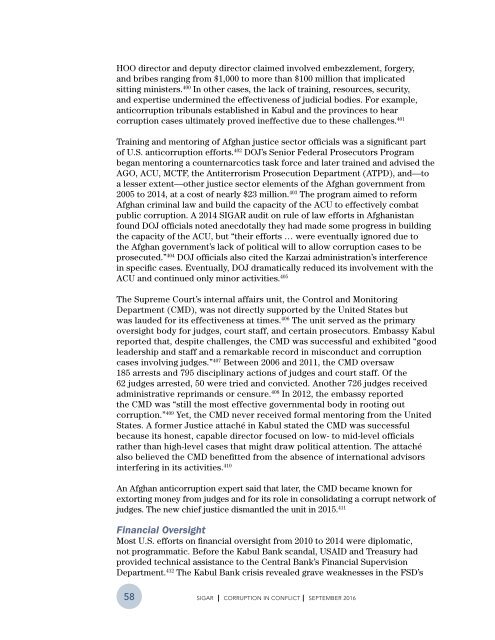CORRUPTION IN CONFLICT
5IlaWjQej
5IlaWjQej
Create successful ePaper yourself
Turn your PDF publications into a flip-book with our unique Google optimized e-Paper software.
HOO director and deputy director claimed involved embezzlement, forgery,<br />
and bribes ranging from $1,000 to more than $100 million that implicated<br />
sitting ministers. 400 In other cases, the lack of training, resources, security,<br />
and expertise undermined the effectiveness of judicial bodies. For example,<br />
anticorruption tribunals established in Kabul and the provinces to hear<br />
corruption cases ultimately proved ineffective due to these challenges. 401<br />
Training and mentoring of Afghan justice sector officials was a significant part<br />
of U.S. anticorruption efforts. 402 DOJ’s Senior Federal Prosecutors Program<br />
began mentoring a counternarcotics task force and later trained and advised the<br />
AGO, ACU, MCTF, the Antiterrorism Prosecution Department (ATPD), and—to<br />
a lesser extent—other justice sector elements of the Afghan government from<br />
2005 to 2014, at a cost of nearly $23 million. 403 The program aimed to reform<br />
Afghan criminal law and build the capacity of the ACU to effectively combat<br />
public corruption. A 2014 SIGAR audit on rule of law efforts in Afghanistan<br />
found DOJ officials noted anecdotally they had made some progress in building<br />
the capacity of the ACU, but “their efforts … were eventually ignored due to<br />
the Afghan government’s lack of political will to allow corruption cases to be<br />
prosecuted.” 404 DOJ officials also cited the Karzai administration’s interference<br />
in specific cases. Eventually, DOJ dramatically reduced its involvement with the<br />
ACU and continued only minor activities. 405<br />
The Supreme Court’s internal affairs unit, the Control and Monitoring<br />
Department (CMD), was not directly supported by the United States but<br />
was lauded for its effectiveness at times. 406 The unit served as the primary<br />
oversight body for judges, court staff, and certain prosecutors. Embassy Kabul<br />
reported that, despite challenges, the CMD was successful and exhibited “good<br />
leadership and staff and a remarkable record in misconduct and corruption<br />
cases involving judges.” 407 Between 2006 and 2011, the CMD oversaw<br />
185 arrests and 795 disciplinary actions of judges and court staff. Of the<br />
62 judges arrested, 50 were tried and convicted. Another 726 judges received<br />
administrative reprimands or censure. 408 In 2012, the embassy reported<br />
the CMD was “still the most effective governmental body in rooting out<br />
corruption.” 409 Yet, the CMD never received formal mentoring from the United<br />
States. A former Justice attaché in Kabul stated the CMD was successful<br />
because its honest, capable director focused on low- to mid-level officials<br />
rather than high-level cases that might draw political attention. The attaché<br />
also believed the CMD benefitted from the absence of international advisors<br />
interfering in its activities. 410<br />
An Afghan anticorruption expert said that later, the CMD became known for<br />
extorting money from judges and for its role in consolidating a corrupt network of<br />
judges. The new chief justice dismantled the unit in 2015. 411<br />
Financial Oversight<br />
Most U.S. efforts on financial oversight from 2010 to 2014 were diplomatic,<br />
not programmatic. Before the Kabul Bank scandal, USAID and Treasury had<br />
provided technical assistance to the Central Bank’s Financial Supervision<br />
Department. 412 The Kabul Bank crisis revealed grave weaknesses in the FSD’s<br />
58<br />
SIGAR I <strong>CORRUPTION</strong> <strong>IN</strong> <strong>CONFLICT</strong> I SEPTEMBER 2016


